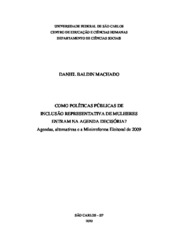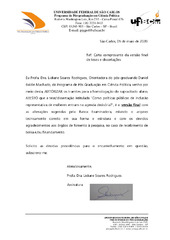Mostrar el registro sencillo del ítem
Como políticas públicas de inclusão representativa de mulheres entram na agenda decisória? agendas, alternativas e a Minirreforma Eleitoral de 2009
| dc.contributor.author | Machado, Daniel Baldin | |
| dc.date.accessioned | 2020-05-22T21:26:02Z | |
| dc.date.available | 2020-05-22T21:26:02Z | |
| dc.date.issued | 2020-03-30 | |
| dc.identifier.citation | MACHADO, Daniel Baldin. Como políticas públicas de inclusão representativa de mulheres entram na agenda decisória? agendas, alternativas e a Minirreforma Eleitoral de 2009. 2020. Dissertação (Mestrado em Ciência Política) – Universidade Federal de São Carlos, São Carlos, 2020. Disponível em: https://repositorio.ufscar.br/handle/ufscar/12787. | * |
| dc.identifier.uri | https://repositorio.ufscar.br/handle/ufscar/12787 | |
| dc.description.abstract | The objective of this study is to comprehend how policies designed to improve women’s political representation are inserted in the decision agenda, by conducting a case study of a significant proposal in the Brazilian political history: the bill 5498/2009, which came to be recalled as “Minirreforma Eleitoral de 2009” once sanctioned. To this end, concepts related to John Kingdon’s Multiple Streams Approach are mobilized, with a special focus on the distinction between agendas and alternatives, which is addressed in distinct moments throughout the dissertation. In a first moment, an analysis of the legislative proposals presented in the Brazilian Chamber of Deputies between 1995 and 2014 is conducted, with the intent to determine a sample of possible cases to be studied, as well as to stablish the criteria which guided the selection of the “Minirreforma Eleitoral de 2009” as a representative case of a policy designed to improve women political representation which reached the decision agenda. Secondly, using as method the qualitative content analysis of shorthand transcripts from the Chamber of Deputies’ plenary speeches – delivered between the beginning of the legislative year until the sanction of the proposal –, the study identifies the theoretical elements described by Kingdon in relation to both the conduction of Brazilian political reform policies to the agenda and the selection of policies which propose changes in political, electoral or party legislations. As a result of this analysis, the study presents the hypothesis that policies designed to improve women political representation are not able to individually reach the last phases of the decision agenda, but they might be incorporated to broader political systems reforms, as occurred in the “Minirreforma Eleitoral de 2009” and possibly happened to other reforms which contemplated policies in favor of women in positions of power. This conclusion, in turn, may be inserted in the political theory debate which opposes the concepts of critical mass and critical actors, offering contributions that allow the suggestion that policies designed to improve women political representation reach the decision agenda through the articulated action of critical actors, and not by a predetermined percentage of political participants of a certain social group, as stablished by the critical mass theory. | eng |
| dc.description.sponsorship | Coordenação de Aperfeiçoamento de Pessoal de Nível Superior (CAPES) | por |
| dc.language.iso | por | por |
| dc.publisher | Universidade Federal de São Carlos | por |
| dc.rights | Attribution-NonCommercial-NoDerivs 3.0 Brazil | * |
| dc.rights.uri | http://creativecommons.org/licenses/by-nc-nd/3.0/br/ | * |
| dc.subject | Estabelecimento de agenda | por |
| dc.subject | Mulheres em espaços de poder | por |
| dc.subject | Múltiplos Fluxos | por |
| dc.subject | Representação política | por |
| dc.subject | Reformas político-eleitorais | por |
| dc.subject | Agenda-setting | eng |
| dc.subject | Women in positions of power | eng |
| dc.subject | Multiple streams | eng |
| dc.subject | Political representation | eng |
| dc.subject | Political and electoral reforms | eng |
| dc.title | Como políticas públicas de inclusão representativa de mulheres entram na agenda decisória? agendas, alternativas e a Minirreforma Eleitoral de 2009 | por |
| dc.title.alternative | How policies designed to improve women's political representation are inserted into the decision agenda? agendas, alternatives and the "Minirreforma Eleitoral de 2009" | eng |
| dc.type | Dissertação | por |
| dc.contributor.advisor1 | Rodrigues, Lidiane Soares | |
| dc.contributor.advisor1Lattes | http://lattes.cnpq.br/5343968646005766 | por |
| dc.description.resumo | Este trabalho tem por objetivo entender como políticas públicas de inclusão representativa de mulheres são inseridas na agenda decisória, empreendendo um estudo de caso de uma proposição significativa para a história política brasileira: o Projeto de Lei 5498/2009, que viria a ser denominada Minirreforma Eleitoral de 2009 assim que ratificada. Para tal finalidade, conceitos relacionados ao Modelo de Múltiplos Fluxos de John Kingdon são mobilizados, considerando principalmente a distinção entre agendas e alternativas que é explorada de distintas maneiras no decorrer da dissertação. Primeiramente, o trabalho apresenta uma análise de proposições legislativas apresentadas na Câmara dos Deputados entre 1995 e 2014, com a finalidade de estabelecer uma amostra de possíveis casos de análise, assim como estabelece os critérios que conduziram a seleção da Minirreforma Eleitoral de 2009 como um caso representativo de medidas de inclusão representativa de mulheres que alcança a agenda decisória. Em seguida, utilizando como principal método a análise de conteúdo qualitativa de notas taquigráficas de discursos no Plenário da Câmara dos Deputados – do início do ano legislativo de 2009 até a ratificação da proposição –, o estudo identifica os elementos teóricos descritos por Kingdon relacionados tanto à condução de reformas no sistema político brasileiro à agenda quando à seleção de políticas públicas que propõem mudanças nas regras políticas, partidárias ou eleitorais. Como resultado dessa análise, o presente trabalho apresenta a hipótese de que políticas de inclusão representativa de mulheres não logram alcançar as últimas etapas da agenda decisória quando propostas de maneira individual, mas podem ser incorporadas a reformas mais amplas no sistema político, como ocorreu no caso da Minirreforma Eleitoral de 2009 e possivelmente se deu em outras reformas que contemplam medidas em prol de mulheres em espaços públicos de poder. Essa conclusão, por sua vez, se insere no debate da teoria política que contrapõe os conceitos de massa crítica e de atores críticos, oferecendo contribuições que permitem sugerir que medidas de inclusão representativa alcançam a agenda decisória pela ação articulada de atores críticos, e não por um percentual predeterminado de participantes de determinado grupo social, como estabelece a teoria da massa crítica. | por |
| dc.publisher.initials | UFSCar | por |
| dc.publisher.program | Programa de Pós-Graduação em Ciência Política - PPGPol | por |
| dc.subject.cnpq | CIENCIAS HUMANAS::CIENCIA POLITICA::POLITICAS PUBLICAS | por |
| dc.subject.cnpq | CIENCIAS HUMANAS::CIENCIA POLITICA::TEORIA POLITICA | por |
| dc.subject.cnpq | CIENCIAS HUMANAS::CIENCIA POLITICA | por |
| dc.description.sponsorshipId | CAPES: Código de Financiamento 001 | por |
| dc.publisher.address | Câmpus São Carlos | por |
| dc.contributor.authorlattes | http://lattes.cnpq.br/2212296811209672 | por |


